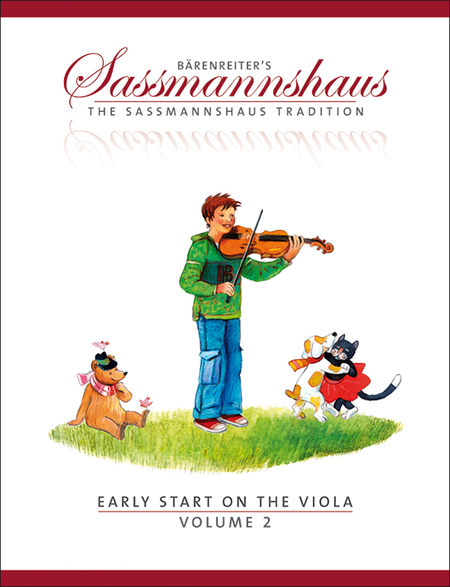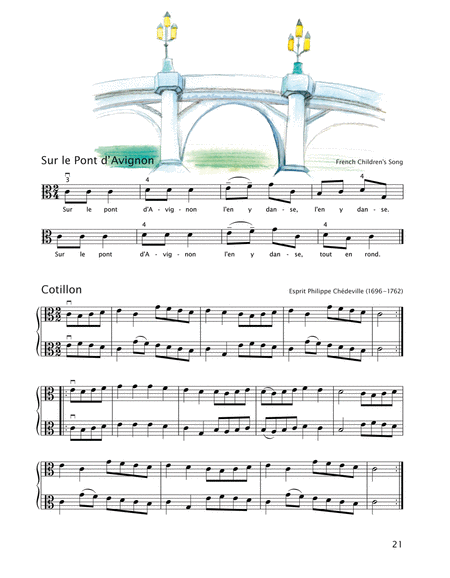Early Start on the Viola, Volume 2
A viola method for children
-
Ships in 1 to 2 weeks
Details
Description
SKU: BA.BA09687
A viola method for children. Composed by Egon Saßmannshaus and Kurt Sassmannshaus. Stapled. Barenreiter's Sassmannshaus. Instructional. Performance score. 64 pages. Baerenreiter Verlag #BA09687. Published by Baerenreiter Verlag (BA.BA09687).ISBN 9790006539291. 30 x 23 cm inches. Language: English. Illustrations: Charlotte Panowsky.
Volume 2 in our series, with colour illustrations and easy-to-read fingering charts, contains not only nursery rhymes and folk songs but also classical recital pieces for two violas to help learners improve their ability to read music. They will become acquainted with dotted notes, 16th notes (semiquavers) and their first double stops as well as with changing between high and low finger positions.
The volume is pioneering with its early introduction of playing in different positions: by combining finger patterns, the cornerstone of good scale technique, learners can play major and minor scales in every position without using open strings – and this often in the very first year of lessons! This allows them to transpose the familiar nursery rhymes they have already mastered into other keys and higher positions. Together with the beginning shifting exercises, it provides a solid basis for early virtuosity – a great advantage offered by no other tutor in the same way.
The authors
In 1976 Egon Sassmannshaus, one of the most experienced and renowned violin teachers in Germany, published his tutor “Früher Anfang auf der Bratsche”. This standard work for young string players quickly became the most popular and best-selling tutor in the German-speaking countries for beginners on the viola. His son Kurt Sassmannshaus functioned as co-editor of the English-language edition, “Early Start on the Viola” (BA 9686, BA 9687, BA 9688, BA 9689), adapting his father's successful tutor to meet the needs and requirements of English-speaking children.
The combined knowledge and experience of both father and son make these four volumes the most thoroughly researched and thought-through viola tutor for beginners all over the world.
About Baerenreiter's Sassmannshaus
Children playfully learn reliable technique at the earliest age. For more than three decades the Sassmannshaus Tradition has been the household name for excellence in beginner methods in German-speaking countries. More than half a million students have successfully learned to play using this publication.
This tried and tested German method is now available in English! The best-selling method that gave generations of European musicians their foundation is now available in English, with content and songs newly adapted for today's English speaking children.
What makes this method so special?
- The child-friendly and age-appropriate text underlying the music enables children to perceive melodies as a whole and to understand their singable qualities.
- Songs and scales in different positions are easily explained and mastered within the first year. This is an important advantage over methods that confine children to the first position for many years.
- Note reading is emphasized from the first lesson - children are brought up to become proficient sight-readers and play in chamber music ensembles as early as possible.
- In contrast to other beginner methods, The Sassmannshaus Tradition progresses swiftly by introducing advanced techniques in rudimentary form, such as shifting and varied bow strokes.
- Ensemble playing is encouraged from the very beginning.
- The method is suitable for single instruction as well as for group and class lessons.
- The large print notes and text as well as many colorful illustrations are particularly child-friendly and very attractive to pre-school children and school children alike.
- The substantial volumes contain comprehensive material and carefully calibrated learning curves. They keep children curious and interested for many months and years.
Song List (19)
- Preface
- The Third Finger Is The Tonic
- Triads in F major, C major, And G major
- Songs with the New Finger Pattern
- The Dotted Quarter Note
- The Second Finger Changes Between High And Low Positions
- The First Finger Is the Tonic
- Triads in D major, A major And E major
- Changing Between High And Low Finger Positions
- The Three Finger Patterns
- Playing In Different Positions With The Three Patterns
- Double Stops
- The Second Finger Is The Tonic
- Triads In E-flat Major, B-flat major and F major
- Sixteenth Notes
- The First Finger Changes Between High And Low Positions
- F major Notes In First Position
- Exercises And Pieces in F major
- Major And Minor Scales And Arpeggios Across Four Strings


 Share
Share